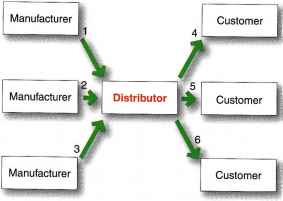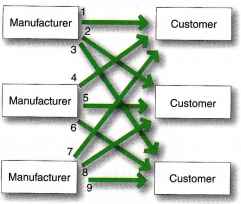Objective 4 Mfu
members, * : ■ . : ■
Discuss the natur : and importance of mark -ting logistics and integrated supply chain man jgement
Marketing Logistics and Supply Chain Management 380-387

Value delivery network: In making and marketing iPod Touch products, Apple manages an entire network of people within Apple plus suppliers and resellers outside the company who work effectively together to give final customers "So much to touch."
however, have traditionally focused on the "downstream" side of the supply chain—on the marketing channels (or distribution channels) that look toward the customer. Downstream marketing channel partners, such as wholesalers and retailers, form a vital connection between the firm and its customers.
The term supply chain may be too limited—it takes a make-and-sell view of the business. It suggests that raw materials, productive inputs, and factory capacity should serve as the starting point for market planning. Abetter term would be demand chain because it suggests a sense-and-respond view of the market. Under this view, planning starts with the needs of target customers, to which the company responds by organizing a chain of resources and activities with the goal of creating customer value.
Even a demand chain view of a business may be too limited, because it takes a step-by-step, linear view of purchase-production-consumption activities. With the advent of the Internet and other technologies, however, companies are forming more numerous and complex relationships with other firms. For example, Ford Motor Company manages numerous supply chains. It also sponsors or transacts on many B-to-B Web sites and online purchasing exchanges as needs arise. Like Ford, most large companies today are engaged in building and managing a continuously evolving value delivery network.
As defined in Chapter 2, a value delivery network is made up of the company, suppliers, distributors, and ultimately customers who "partner" with each other to improve the performance of the entire system. AFor example, in making and marketing its iPod Touch products, Apple manages an entire network of people within Apple plus suppliers and resellers outside the company who work together effectively to give final customers "So much to touch."
This chapter focuses on marketing channels—on the downstream side of the value delivery network. We examine four major questions concerning marketing channels:
Value delivery network: In making and marketing iPod Touch products, Apple manages an entire network of people within Apple plus suppliers and resellers outside the company who work effectively together to give final customers "So much to touch."
Chapter 12 ¡ Marketing Channels: Delivering Customer Value 363
Value delivery network
The network made up of the company, suppliers, distributors, and ultimately customers who "partner" with each other to improve the performance of the entire system in delivering customer value.
What is the nature of marketing channels and why are they important? How do channel firms interact and organize to do the work of the channel? What problems do companies face in designing and managing their channels? What role do physical distribution and supply chain management play in attracting and satisfying customers? In Chapter 13, we will look at marketing channel issues from the viewpoint of retailers and wholesalers.
Author I in this section, we look at Comment | "downstream" side of the value delivery network—the marketing channel organizations that connect the company and its customers. To understand their value, imagine life without retailers—say, grocery stores or department stores.
Marketing channel (or distribution channel)
A set of interdependent organizations that help make a product or service available for use or consumption by the consumer or business user.
Few producers sell their goods directly to the final users. Instead, most use intermediaries to bring their products to market. They try to forge a marketing channel (or distribution channel)—a set of interdependent organizations that help make a product or service available for use or consumption by the consumer or business user.
A company's channel decisions directly affect every other marketing decision. Pricing depends on whether the company works with national discount chains, uses high-quality specialty stores, or sells directly to consumers via the Web. The firm's sales force and communications decisions depend on how much persuasion, training, motivation, and support its channel partners need. Whether a company develops or acquires certain new products may depend on how well those products fit the capabilities of its channel members. For example, Kodak initially sold its EasyShare printers only in Best Buy stores to take advantage of the retailer's on-the-floor sales staff and their ability to educate buyers on the economics of paying higher initial prices but lower long-term ink costs.
Companies often pay too little attention to their distribution channels, sometimes with damaging results. In contrast, many companies have used imaginative distribution systems to gain a competitive advantage. FedEx's creative and imposing distribution system made it a leader in express delivery. Enterprise revolutionized the car-rental business by setting up off-airport rental offices. And Calyx & Corolla led the way in selling fresh flowers and plants direct to consumers by phone and from its Web site, cutting a week or more off the time it takes flowers to reach consumers through conventional retail channels.
Distribution channel decisions often involve long-term commitments to other firms. For example, companies such as Ford, Nestle, or Sony can easily change their advertising, pricing, or promotion programs. They can scrap old products and introduce new ones as market tastes demand. But when they set up distribution channels through contracts with franchisees, independent dealers, or large retailers, they cannot readily replace these channels with company-owned stores or Web sites if conditions change. Therefore, management must design its channels carefully, with an eye on tomorrow's likely selling environment as well as today's.
How Channel Members Add Value
Why do producers give some of the selling job to channel partners? After all, doing so means giving up some control over how and to whom they sell their products. Producers use intermediaries because they create greater efficiency in making goods available to target markets. Through their contacts, experience, specialization, and scale of operation, intermediaries usually offer the firm more than it can achieve on its own.
^Figure 12.1 shows how using intermediaries can provide economies. Figure 12.1A shows three manufacturers, each using direct marketing to reach three customers. This system requires nine different contacts. Figure 12.1B shows the three manufacturers working through one distributor, which contacts the three customers. This system requires only six contacts. In this way, intermediaries reduce the amount of work that must be done by both producers and consumers.

Manufacturer
Customer
Distributor
Customer
Manufacturer
Customer
How Adding a Distributor Reduces the Number of Channel Transactions
Marketing channel intermediaries make buying a lot easier for consumers. Again, think about life without grocery retailers. How would you go about buying that 12-pack of Coke or any of the hundreds of other items that you now routinely drop into your shopping cart?
A. Number of contacts without a distributor
MxC=3x3=9
B. Number of contacts with a distributor
From the economic system's point of view, the role of marketing intermediaries is to transform the assortments of products made by producers into the assortments wanted by consumers. Producers make narrow assortments of products in large quantities, but consumers want broad assortments of products in small quantities. Marketing channel members buy large quantities from many producers and break them down into the smaller quantities and broader assortments wanted by consumers.
For example, Unilever makes millions of bars of Lever 2000 hand soap each day, but you want to buy only a few bars at a time. So big food, drug, and discount retailers, such as Tesco and Wal-Mart, buy Lever 2000 by the truckload and stock it on their stores' shelves. In turn, you can buy a single bar of Lever 2000, along with a shopping cart full of small quantities of toothpaste, shampoo, and other related products as you need them. Thus, intermediaries play an important role in matching supply and demand.
In making products and services available to consumers, channel members add value by bridging the major time, place, and possession gaps that separate goods and services from those who would use them. Members of the marketing channel perform many key functions. Some help to complete transactions:
• Information: Gathering and distributing marketing research and intelligence information about actors and forces in the marketing environment needed for planning and aiding exchange.
• Promotion: Developing and spreading persuasive communications about an offer.
• Contact: Finding and communicating with prospective buyers.
• Matching: Shaping and fitting the offer to the buyer's needs, including activities such as manufacturing, grading, assembling, and packaging.
• Negotiation: Reaching an agreement on price and other terms of the offer so that ownership or possession can be transferred.
Others help to fulfill the completed transactions:
• Physical distribution: Transporting and storing goods.
• Financing: Acquiring and using funds to cover the costs of the channel work.
• Risk taking: Assuming the risks of carrying out the channel work.
The question is not whether these functions need to be performed—they must be—but rather who will perform them. To the extent that the manufacturer performs these functions, its costs go up and its prices must be higher. When some of these functions are

Manufacturer
Customer
Manufacturer
Customer
Manufacturer
Customer shifted to intermediaries, the producer's costs and prices may be lower, but the intermediaries must charge more to cover the costs of their work. In dividing the work of the channel, the various functions should be assigned to the channel members who can add the most value for the cost.
Channel level
A layer of intermediaries that performs some work in bringing the product and its ownership closer to the final buyer.
Direct marketing channel
A marketing channel that has no intermediary levels.
Indirect marketing channel
Channel containing one or more intermediary levels.
Number of Channel Levels
Companies can design their distribution channels to make products and services available to customers in different ways. Each layer of marketing intermediaries that performs some work in bringing the product and its ownership closer to the final buyer is a channel level. Because the producer and the final consumer both perform some work, they are part of every channel.
The number of intermediary levels indicates the length of a channel. 1 Figure 12.2A shows several consumer distribution channels of different lengths. Channel 1, called a direct marketing channel, has no intermediary levels; the company sells directly to consumers. For example, Mary Kay and Avon sell their cosmetics door-to-door, through home and office sales parties, and on the Web; GEICO sells direct via the telephone and the Internet. The remaining channels in Figure 12.2A are indirect marketing channels, containing one or more intermediaries.
Figure 12.2B shows some common business distribution channels. The business marketer can use its own sales force to sell directly to business customers. Or it can sell to various types of intermediaries, who in turn sell to these customers. Consumer and business marketing channels with even more levels can sometimes be found, but less often. From the producer's point of view, a greater number of levels means less control and greater channel complexity. Moreover, all of the institutions in the channel are connected by several types of flows. These include the physical flow of products, the flow of ownership, the payment flow, the information flow, and the promotion flow. These flows can make even channels with only one or a few levels very complex.
Using direct channels, a company sells directly to consumers (no surprise there!).
Continue reading here: Real Erh
Was this article helpful?
Readers' Questions
-
angelica1 year ago
- Reply
-
CELEDOR1 year ago
- Reply
